
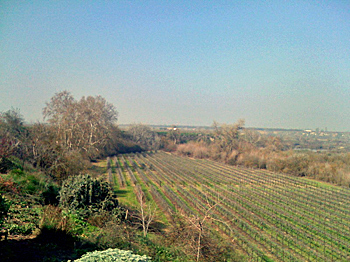
You can table your conception that wines from the Central Valley are only for table wines when you taste the Syrah from this vineyard.
Fresno County (County Appellation)
Central Valley Winery Moves Beyond Low-End Table Wines
Fresno Winegrower Frank Saviez delivers on quality and competition from a region not known for high-end wine.
by
Courtney Cochran
February 24, 2009
 ust north of the sleepy Central Cal metropolis of Fresno, there’s a battle going on between two sides of a river. There, amidst rows of Thompson Seedless and almond trees that stretch as far as the eye can see, two foes eye each other from opposite sides of the San Joaquin River, waiting with bated breath to see who will emerge victorious when the struggle’s through.
ust north of the sleepy Central Cal metropolis of Fresno, there’s a battle going on between two sides of a river. There, amidst rows of Thompson Seedless and almond trees that stretch as far as the eye can see, two foes eye each other from opposite sides of the San Joaquin River, waiting with bated breath to see who will emerge victorious when the struggle’s through.
Fortunately, these foes are fighting for the same team – sort of, anyway.
As one might imagine, the team uniting these adversaries is a formidable player, indeed.
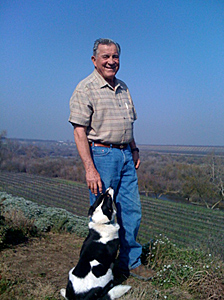
Frank Saviez
To be fair, these winegrowers aren’t your typical foes. For starters, their rivalry is good-natured. As Frank Saviez, the winegrower on the south side of the river, puts it: “We’re [both] just trying to make good wine in the Central Valley – not necessarily an easy task.” Both Saviez and his friendly rival from across the way, Ralph Fäsi, farm Syrah on the banks of the Central Valley’s largest waterway – a spot that’s quickly becoming a hotbed for superior wines from this part of California. The most obvious difference in their wines – both bottled as popular vineyard designates by Fresno State – is that of geography. Fäsi’s vineyard sits on the north bank of the river, a spot recognized as Madera County, while Saviez’s is on the south, in Fresno County.
Terroir Makes Two
To be sure, there exists a low but growing critical buzz about Fäsi’s wines, which show up not only in bottling from FSU but also under private label as “Fäsi Crest,” a brand the grower operates separately from the university’s wine program. Syrah fruit from Fäsi’s 42-acre riverside vineyard – which was planted in 2000 and is certified organic – is the secret to both the Fresno State and private label wines, the latter of which have scored silver and – most recently – gold medals at the annual San Francisco Chronicle wine competition.And with Fäsi wines selling at price points firmly rooted in ultra-premium wine territory – the 2006 Fäsi Estate Vineyards Private Reserve Madera County Syrah runs a cool $24 a bottle – there remains little doubt among enthusiasts and critics alike that Madera is emerging as a solid contender in the quality wine sector.
Fresno County, on the other hand, lags behind its northern neighbor in terms of progress in quality wine production, at least if one is to believe the relative dearth of press attributed to the region’s vintages. When I point this out to Saviez, he is quick to highlight a quiet but critical victory that his very own riverside Syrah scored back in 2001 at the California State Fair. That year, Fresno State’s newly
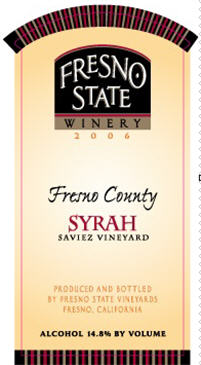 minted winery took home silver medal honors from the prestigious statewide competition, for a Syrah made with fruit from Saviez’s vineyard. It’s a feat that, together with several other medal wins at the same event, was a watershed accomplishment for Central California – and Fresno County – winegrowing.
minted winery took home silver medal honors from the prestigious statewide competition, for a Syrah made with fruit from Saviez’s vineyard. It’s a feat that, together with several other medal wins at the same event, was a watershed accomplishment for Central California – and Fresno County – winegrowing.
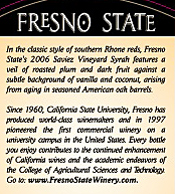
A slight enlargement of the back label of the Fresno State Syrah.
Without a doubt the most concrete proof of style and staying power where Saviez’s Syrah is concerned comes from an older vintage, one that I sampled, by necessity, from bottle. Ten years after its smash debut, the 1999 Fresno State Winery Saviez Farms Syrah is reminiscent of Northern Rhône renderings of the grape, with focused aromas of deli meat, smoke, pepper and cooked plums fairly singing from the glass.
Could this mean that the cross-river rivalry just got more serious?
Saviez Ups the Ante
From the bluffs behind his home, which overlooks his favorite block of Syrah and the river beyond, Saviez shared his thoughts with me about the future of valley wines. Notably, he attributes his wines’ success to the unique microclimate created by the San Joaquin riverbed. “Temperatures near the river are cooler than those further away,” he notes. This detail is no doubt a near-necessity for quality wine production in a region where summertime temperatures frequently top out north of 100 degrees, and rarely dip below 70 during the warmest months. This is a factor that – for obvious reasons – also benefits Fäsi, and is at the heart of the reason why Fresno State continues to choose fruit from these proximate locales when crafting its wines, year in and year out.To further enhance his vines’ chances of turning out premium-quality wine, Napa Valley native Saviez says he employs shoot and bunch thinning to drive down
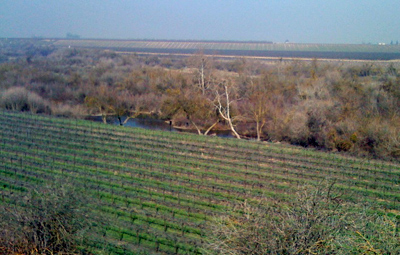
Frank Saviez’s vineyard on the south side of the San Joaquin River.
As discussed in a related article featuring an interview with FSU’s outgoing Chair of Viticulture and Enology, Dr. Robert Wample, this tendency for valley vineyards to produce copious amounts of sub-par fruit is the key obstacle in Central California wines assuming a strong – and lasting – position on the quality wine stage.
As Wample’s testimony attests, it’s not all Two Buck Chuck and jug wines that are grown in the valley, though quality winegrowing on a widespr










 READER FEEDBACK: To post your comments on this story,
READER FEEDBACK: To post your comments on this story,


